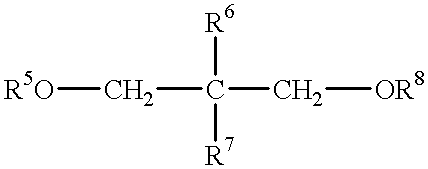Process for producing solid catalyst component and catalyst for alpha-olefin polymerization, and process for producing alpha-olefin polymer
a technology of solid catalyst and alpha-olefin polymer, which is applied in the direction of catalyst activation/preparation, chemical/physical processes, hydrocarbons, etc., can solve the problems of increasing the rigidity of injection-molded objects with increasing stereospecificity, and the stereospecificity of -olefin polymer obtained by polymerization using any of the above mentioned catalysts. achieve high polymerization activity
- Summary
- Abstract
- Description
- Claims
- Application Information
AI Technical Summary
Benefits of technology
Problems solved by technology
Method used
Image
Examples
example 1
(1) Production of Solid Product
A 500 ml flask equipped with a stirrer and a dropping funnel was purged with nitrogen, and thereafter 270 ml of hexane, 7.5 ml (22 mmol) of tetrabutoxytitanium, 2.5 ml (9.3 mmol) of di-i-butyl phthalate and 74 ml (329 mmol) of tetraethoxysilane were fed therein to obtain a uniform solution.
Successively, 172 ml of a di-n-butyl ether solution of n-butylmagnesium chloride (manufactured by Yuki Gosei Kogyo Co., Ltd., n-butylmagnesium chloride concentration: 2.1 mmole / ml) was gradually added dropwise from the dropping funnel thereto over 3 hours while maintaining a temperature in the flask at 5° C. After completion of the addition, the mixture was stirred at 5° C. for 30 minutes, and additionally stirred for 1.5 hours at 35° C. Thereafter, the reaction mixture was cooled to room temperature, and subjected to solid-liquid separation. The solid product separated was washed 3 times with each 200 ml of toluene, and then mixed with 200 ml of toluene to obtain a ...
example 2
(1) Production of Solid Catalyst Component
A 100 ml flask equipped with a stirrer, a dropping funnel and a thermometer was purged with nitrogen. Thereafter, 52.7 ml of the solid product slurry obtained in Example 1 (1) was fed in the flask, and 6.2 ml of a supernatant liquid was taken out. The residue was stirred for 1 hour at 105° C., and cooled to 95° C. Then, 6.8 ml (25.4 mmol) of di-i-butyl phthalate was added thereto, and contact was effected at 95° C. for 30 minutes. Thereafter, the resulting solid was separated from the liquid at that temperature and washed two times with each 40 ml of toluene at room temperature.
After completion of washing, 10 ml of toluene was added thereto. Further, a mixture of 0.8 ml (4.73 mmol) of butyl ether, 0.45 ml (1.68 mmol) of di-i-butyl phthalate and 16 ml (0.146 mol) of titanium tetrachloride was added thereto, and contact was effected at 105° C. for 3 hours. Thereafter, the resulting solid was separated from the liquid at that temperature and wa...
example 1 (
3) was repeated to polymerize propylene, except that the solid catalyst component obtained in the above (1) was used as the solid catalyst component. The results are as shown in Table 1.
PUM
| Property | Measurement | Unit |
|---|---|---|
| valence | aaaaa | aaaaa |
| rigidity | aaaaa | aaaaa |
Abstract
Description
Claims
Application Information
 Login to View More
Login to View More - R&D
- Intellectual Property
- Life Sciences
- Materials
- Tech Scout
- Unparalleled Data Quality
- Higher Quality Content
- 60% Fewer Hallucinations
Browse by: Latest US Patents, China's latest patents, Technical Efficacy Thesaurus, Application Domain, Technology Topic, Popular Technical Reports.
© 2025 PatSnap. All rights reserved.Legal|Privacy policy|Modern Slavery Act Transparency Statement|Sitemap|About US| Contact US: help@patsnap.com



